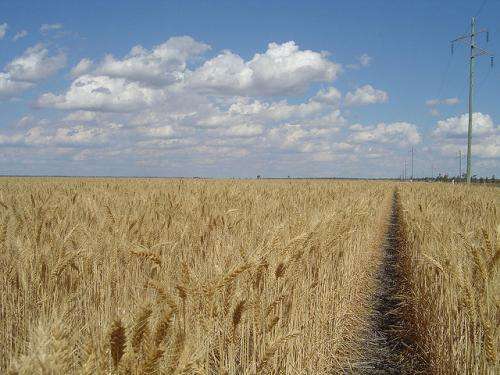Climate projections show ways to improve crop yields

New computer modelling shows farmers need to adopt remedial measures to prevent crop yields in western and eastern Australian agricultural districts declining over the next 75 years.
Research shows that including breeding varieties that are more drought-tolerant and heat-resistant, using better weather forecasting methods and adopting strategies to retain more moisture in the soil could help.
Agronomists made the prediction after 'virtually growing' six key crops inside a computer, using climate projection data from the Bureau of Meteorology and APSIM (Agricultural Production Systems Simulator) software.
They chose to model wheat, barley, lupin, canola and field peas at Cunderdin and Katanning in WA, Hamilton in Victoria and Wagga Wagga in NSW, using three different soil types at each location.
Lead author and cropping system modeller Muhuddin Rajin Anwar, from the NSW Department of Primary Industries Wagga Wagga Agricultural Institute, says reduced rainfall is expected to reduce both crop biomass and grain yield in all four locations.
Cunderdin, the lowest rainfall area in the study, is likely to suffer a 26 per cent annual rainfall decline by 2090, resulting in 23.4 per cent less wheat production if current farming methods and varieties continue to be used.
Field pea production could be as much as 45 per cent lower.
"We found that generally, the field pea was more sensitive than wheat," Dr Anwar says.
"But obviously in terms from a commercial point of view wheat is more extensively grown in many parts of Western Australia as well as for New South Wales."
Dr Anwar says before making its predictions, his team tested the APSIM software by growing virtual crops in the computer at these locations for each of the years 1961-2010.
The agronomists then made similar calculations for the years 2030, 2060 and 2090, using Global Climate Models from the World Climate Research Program.
"There is this message for farmers and breeders that they will be required to change lots of technology in agronomy or breeding or manipulating the management," Dr Anwar says.
He says this includes breeding varieties that are more drought-tolerant and heat-resistant, and adopting strategies to retain more moisture in the soil.
Better weather forecasting, such as the Predictive Ocean Atmosphere Model for Australia (POAMA) method the Bureau of Meteorology is trialling in some places, should also allow farmers to make better planting and cropping plans.
"If farmers are aware that expected rainfall in three months' time will be particularly dry or wet, they can modify their management," Dr Anwar says.
He says currently, forecasting skills vary from place to place and from month to month.
More information: Muhuddin Rajin Anwar, De Li Liu, Robert Farquharson, Ian Macadam, Amir Abadi, John Finlayson, Bin Wang, Thiagarajah Ramilan, "Climate change impacts on phenology and yields of five broadacre crops at four climatologically distinct locations in Australia," Agricultural Systems, Volume 132, January 2015, Pages 133-144, ISSN 0308-521X, dx.doi.org/10.1016/j.agsy.2014.09.010
Provided by Science Network WA




















